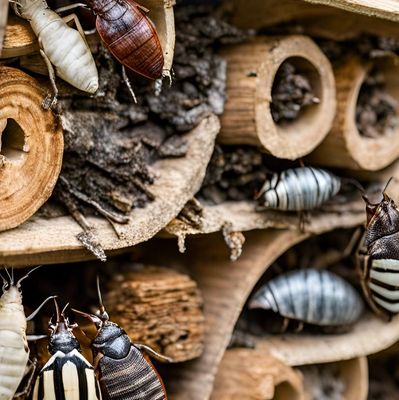What's up with woodlice
When it comes to bug hotels, woodlice are the unassuming yet essential visitors that help keep your operations running smoothly. These little guests might not demand a fancy suite, but they’re nature’s cleanup crew, working tirelessly to recycle nutrients and maintain a healthy garden ecosystem.
Let’s take a closer look at these humble lodgers and why they deserve a spot in your hotel:
Meet the Woodlice: Your VIP Guests (Very Important Pulverizers)
Woodlice, also known as terrestrial isopods, are small, segmented crustaceans often found in damp, dark corners of the garden. Think of them as the housekeeping team of your bug hotel—they thrive in the forgotten spaces and take care of the decomposing plant material others might leave behind.
Nutrient Recycling Pros
Woodlice are composters extraordinaire, feeding on damp, decaying plant material and breaking it down into nutrients that enrich your soil. It’s like having a round-the-clock composting service built into your garden! Woodlice are also a critical menu item for garden predators like shrews, toads, spiders, centipedes, and parasitic flies. By hosting woodlice, you’re feeding an entire ecosystem of beneficial creatures.
Every guest has their preferences, and woodlice are no exception:
Preferred Suites: Dark, damp hideaways like logs, cracks, and gaps in nesting materials.
Dining Choices: Rotting leaves, dead plant material, and the occasional soft fruit or seedling.
Social Habits: These communal creatures are perfectly content to share spaces with other guests like centipedes and spiders.
Celebrate Biodiversity
Woodlice aren’t just guests—they’re essential contributors to your garden’s ecosystem. By hosting them, you’re supporting soil health and helping other beneficial creatures thrive. While they may not roll out a welcome mat, woodlice are the kind of guests every hotelier dreams of—hardworking, low-maintenance, and vital to the success of your establishment.
Woodlice clean up after others, feed the locals, and quietly enrich the garden ecosystem.
So, the next time you spot a woodlouse scuttling around your bug hotel, give it a little nod of appreciation. They may not need a luxury suite, but they’re the backbone of your bug hotel’s success—always working behind the scenes to keep your establishment thriving!

Copyright © 2024 Bug Hotel Rewilding Project - All Rights Reserved.
Morgan Todhunter